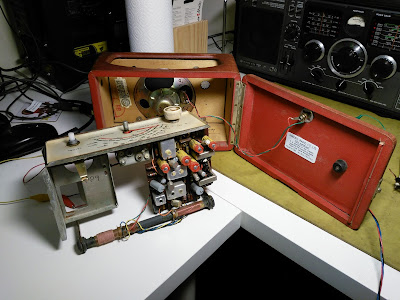In about 2011, I was given an old transistor radio. It certainly hadn't been used for many years, and I thought it might be interesting to breathe some life into it. It is a very basic set - just medium and long wave, but is old enough to be interesting. I think it dates from about 1962, and as such is from the early years of transistor radios. It uses germanium transistors. The audio output stage is transformer coupled, which is a feature of most valve designs that preceded it.
A simple catch allows the back cover to be opened.
I found a service manual for it online (£1.99 from http://www.service-data.com) which was very helpful as it includes the schematic and alignment instructions. Rather to my surprise, the radio worked as soon as power was supplied, but unfortunately not very well. It was rather insensitive and the tuning scale was inaccurate.
 Removing the chassis was straightforward and allowed a general clean-up
of the scale and other parts that are not normally accessible. The set
does not appear to have been worked on previously, which is good to see.
Removing the chassis was straightforward and allowed a general clean-up
of the scale and other parts that are not normally accessible. The set
does not appear to have been worked on previously, which is good to see.
 Following the alignment procedure is a good way of finding issues with a radio if you have the equipment and the patience. In this case, the alignment was pretty close with the exception of the preselection filter. These are tuned by moving the coils on the antenna ferrite rod. Unfortunately, the coils had become loose with age moved from their proper position. This was the main cause of the insensitivity.
Following the alignment procedure is a good way of finding issues with a radio if you have the equipment and the patience. In this case, the alignment was pretty close with the exception of the preselection filter. These are tuned by moving the coils on the antenna ferrite rod. Unfortunately, the coils had become loose with age moved from their proper position. This was the main cause of the insensitivity.
Another issue was that the ferrite cores are held in the IF transformers by small pieces of what I imagine was once elastic. I had to replace these to enable the cores to be adjusted without them falling completely though the coil! This (right) is the inside of one of the transformers.
On the whole, the radio works about as
well as I would expect for such a comparatively simple radio. Contrary
to popular opinion, the electrolytic capacitors still work, at least
well enough to perform their intended functions. Don't believe
everything you read about old capacitors!
This
radio is now in semi-regular use in my living room. Reception on the internal rod is tolerable,
though it does perform much better when connected to the long-wire antenna I have run
down the garden!






No comments:
Post a Comment